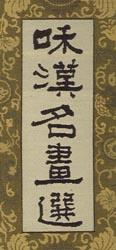|
Condition. The book is in Very Good condition. There is fraying of the cloth along the edges and corners. One place at the top has a 1/4 inch tear of the cloth. Internally the plates are very clean with no damage to the image areas or tissue guards. There is some darkening of the plate margins, particularly along the outside edge. Faint water staining to the very bottom edge of a few leaves. Significant loss of fabric covering the spine.
Murayama, Jungo:
A Gallery of Japanese and Chinese Paintings, Tokyo, The Kokka Publishing Company (Yazaemon-cho, Kyobashi-ku), folio (17 x 12 in), 100 plates (72 in black and white collotype and 28 tipped in color woodblock prints), gold and green brocade silk over boards, string tied. All plates are on thick card stock paper. Of the color plates 19 are of Japanese art and 8 are of Chinese art. The plates is protected by a descriptive tissue guards with information in English and Japanese. Each tissue guard provides information on the art and notes it's location. At times two plates are consolidated and have only one descriptive tissue guard before the first plate. All plates are on thick card stock paper.
In the preface the compilers of the book note:
.... the editorial staff of the Kokka Company, has been compiled the present volume, presenting one hundred of what may be considered to be the choicest of ancient Japanese and Chinese paintings.
In the Japanese section we have chosen sixty-five representative productions extending in date from the reign of the Empress Suiko down to the close of the Tokugawa period; while, under the heading of China, we have included the equally typical specimens of the three dynasties of T'ang, Yuan, and Sung. The reason why we have chosen the productions of these dynasties to the exclusion of the Ming and the Ch'ing periods, is that the art of these three dynasties has had the closest bearing on ours.
Another characteristic of the present volume is the insertion of an unusually large number of coloured wood-engravings, 28 in all, a number rather exceptional in a work of this size. We desire to add that all these coloured prints are of that unequalled workmanship which is to be expected from the hands of artizans in the exclusive employment of the Kokka Company. (English Language Preface)
The Kokka Company published a series of at least four, including this book, art reproduction books of this type during the period of 1906-1908. This was the last and most expensive book and it was priced at double and triple the price of the other books. For more information on the Kokka Company and this series of books, click here.
Kazumasa Ogawa was associated with the Kokka at the time this book was published. While I find no attribution to him, it is very likely the collotype plates were based upon his photographs.
To see the:
- Table of plates (in Japanese), click here.
- Preface (in Japanese) click here.
- Preface (in English) click here.
Table of Contents - Plates * = Color Woodblock Prints, Tipped In
Japanese Paintings
SUIKO PERIOD
- I. Paintings on the Tamamushi Household Shrine
NARA PERIOD
- II. From the Mural Paintings in the Kondo of the Horyu-ji Temple
- * III. Portrait of Prince Shotoku
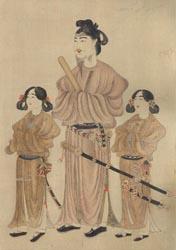
- * IV. Portrait of Kichijo-ten
- V. From a Folding-Screen with Female Figures, in the Collection of the Shoso-in Imperial Repository
- * VI. From the Kwako-genzai-ingwakyo

HEIAN PERIOD
Wocho Period
- * VII. Amida and Attending Deities
- VIII. Amida and Attending Deities
- IX. Portrait of Emma-ten
Fujiwara Period
- * X. Portrait of Fudo-myowo
- XI. Amida and the Twenty-Five Bosatsus, attributed to Priest Eshin-sozu
- XII. The Death Scene of Buddha
- * XIII. From the Senzui-Byobu
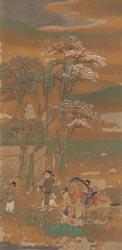
- XIV. Portrait of Fugen-Bosatsu
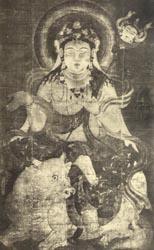
- XV. The Resurrection of Sakyamuni
- XVI. Door-Painting in the Ho-wo-do in Uji, by Tamenari Takuma
- XVII. Vision of the Gods Behind the Mountains
- XVIII. Portrait of Kujaku-myowo
Heike Period
- * XIX. A Scene from the Genji-monogatari by Takayoshi Fujiwara
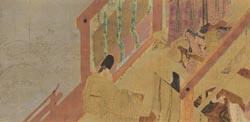
- XX. Frontispiece Paintings in Hand-Copied Buddhist Scriptures, by members of the Taira Family
- XXI. Animal Caricatures, by Toba-sojo Gakuyu
- XXII. Legends of the chief God of the Shigizan Temple, attributed to Toba-sojo Gakuyu
- * XXIII. The Anecdotes of Ban-Dainagon, attributed to Mitsunaga Fujiwara

KAMAKURA PERIOD
- XXIV. Fugen-bosatsu and the Ten Rasetsujos
- * XXV. Portrait of Monju
- * XXVI. Portrait of Gatten by Shoga Taktma
- XXVII. A Scene from the Heiji-monogatari, attributed to Keion Sumiyoshi
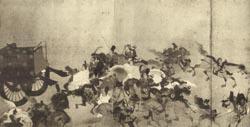
- XXVIII. A Scene from the Kasuga-gongen-Kenki by Takakane Takashina
- XXIX. A Scene from the Life of Priest Ippen
ASHIKAGA PERIOD
- * XXX. Fishing with Cormorants, by Yukihide Kasuga

- XXXI. Rakans, by Priest Mincho
- XXXII. Portrait of Yuima, by Bunsei
- XXXIII. A Landscape, by Shubun
- * XXXIV. Portrait of Daruma by Jasoku
- XXXV. A Landscape, by Priest Sesshu
- XXXVI. A Landscape, by Keishoki

- XXXVII. A Landscape, by So-ami
- XXXVIII. An Autumn Landscape, by Masanobu Kano
- XXXIX. Chinese Priest Wei-shan Kicking over a Vessel, by Motonobu Kano
- XL. Summer and Winter Scenes, by Sesson
MOMOYAMA PERIOD
- XLI. An Aged Pine Tree, by Eitoku Kano
- XLII. The Four Sages of Mount Shang-Shan, by Yusho Kaihoku
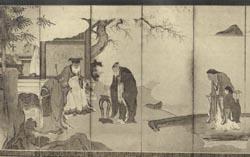
- XLIII. A Scene from the Genji-monogatari, Sanraku Kano
TOKUGAWA PERIOD
- * XLIV. The Hikone-Byobu

- XLV. A Shrike by Niten Miyamoto
- XLVI. The Three Smiling Sages at the Tigers' Vale, by Shokwado Shojo
- XLVII. From an Illuminated Scroll containing the Hyakunin-Isshu Verses, by Koetsu Honnami
- XLVIII. A Lotus Pond, by Sotatsu Nomura
- XLIX. The Chinese Emperor Huang-ti, by Tannyu Kano
- L. A Stage, by Moronobu Hishikawa
- * LI. Plum Tree, by Korin Ogata
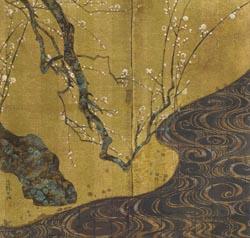
- * LII. The Nunozarashi Dance, by Itcho Hanabusa
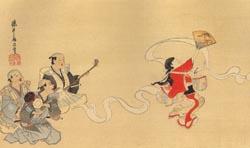
- * LIII. A Musical Feast in Autumn Night, by Choshun Miyagawa
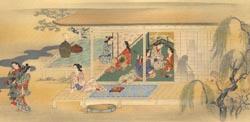
- LIV. A Savant, by Taigwa Ikeno
- * LV. A Summer Landscape, by Buson Yosa
- * LVI. Puppies and Convolvulus, by Okyo Maruyama

- * LVII. A Beauty, by Utamaro Kitagawa
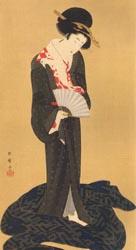
- LVIII. A Deer by a Maple Tree, by Groshun Matsutnura
- LIX. Mandarin Bucks and Plum Trees by Keibun Matsumura
- LX. Flowering Plants in Summer after a Shower, by Hoitsu Sakai
- LXI. Landscapes, by Buncho Tani
- LXII. An Old Temple on a Pine-clad Mountain by Chikuden Tanomura
- LXIII. A Goose in the Snow, by Kwaza Watanabe
- LXIV. Portrait of Susano-No-mikoto, by Hokusai Katsushika
- LXV. Tokwaido Scenes, by Ichiryusai Hiroshige
Chinese Paintings
T'ANG DYNASTY
- * I. Portrait of Priest Pu-'kung-chin-kang, by Li Chien
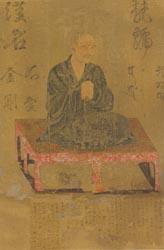
SUNG DYNASTY
- * II. Portraits of Two Arhats, attributed to Li Lung-mien
- III. Portraits of Two Arhats, attributed to Li Lung-mien
- IV. A Flock of Gulls in the River attributed to Chao Ta-nien
- V. Mountains After Rain, by Lutig-men-man-shih
- VI. Autumn and Winter Landscapes, attributed to the Emperor Huitsung
- VII. Autumn and Winter Landscapes, attributed to the Emperor Huitsung
- * VIII. A Herdsman Returning Homeward, by Li Ti
- * IX. A Herd of Cattle in the Field, attributed to Yen ' Tzu-ping
- X. Puppies, attributed to Mao I

- * XI. A Sage admiring a Moon-lit View, attributed to Ma Yuan
- * XII. A Solitary Angler in a Wintry River, attributed to Ma Yuan
- XIII. A Winter Scene, attributed to Ma Lin
- XIV. A Summer Landscape, attributed to Hsia Kuei
- * XV. A Craggy Mountain Lane, attributed to Hsia Kuei
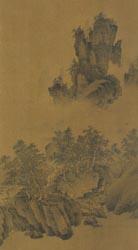
- XVI. A Sage under a Pine Tree, attributed to Hsia Kuei
- XVII. A Dancing Pu-tai, by Liang-k'ai
- XVIII. Hanshan and Shihte, attributed to Liang-k'ai
- XIX. Fish in Nature, attributed to Fan Anjen

- XX. Kwannon and Monkeys and a Crane, by Mu-ch'i
- XXI. Kwannon and Monkeys and a Crane, by Mu-ch'i
- XXII. A Dragon in the Clouds, by Mu-ch'i
- XXIII. Portrait of Priest Wu-chun
- XXIV. A Summer Landscape, by Yii-chien
- XXV. Portrait of Sakyatrmni
- XXVI. Lanscapes
- XXVII. Landscapes
- XXVIII. Priest Hsian-chuang on his Homeward Journey from India
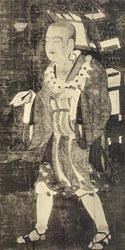
YUAN DYNASTY
- * XXIX. A Cockscomb, by ' Chicn Sliun-chu
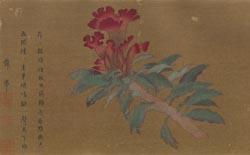
- XXX. A Summer Landscape, attributed Sun Chun-tse
- XXXI. The Hermits T'ieh-kuai and Hsia-ma Yen Hui
- * XXXII. A Moon-lit Sea
- XXXIII. Portrait of Lin Ho-Ching, by Sheng Tsu-chao
- XXXIV. Priest Tan-hsia Burning a Buddhist Statute, attributed to Indra
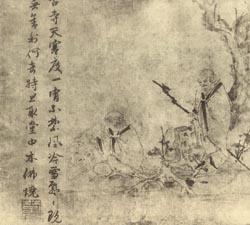
- XXXV. A Mountain After the Rain, attributed to Kao Jan-hui
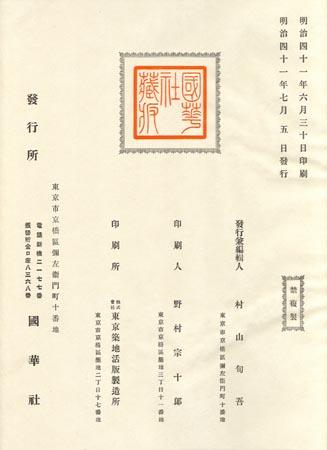
For information on Kazumasa Ogawa, click here.
|

